|
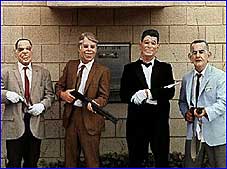 By
1993 Langan was
set loose and set up in Ohio, where he was to cooperate with authorities in locating Guthrie. Langan, however, had other plans. He located his old friend Guthrie, and together they disappeared or "went to ether," as Langan phrased it. They rented a "safe house" in Pittsburg, Kansas. Together, along with a handful of others -- Scott Stedeford, Michael Brescia, Kevin McCarthy, Andreas Strassmeir, Mark William Thomas, et al. -- the ARA was in
action. Using cheap getaway cars and a series of humorous disguises -- including masks of ex-presidents like Nixon, Carter and Clinton, construction worker hard hats, a Santa Claus suit, and even T-shirts with FBI or ATF logos -- two gang members would enter a bank heavily armed, as a third waited in the getaway car. One member would vault the counter and clean out the drawers, while the other held employees and customers at bay. "No alarms no hostages!" was their standard instruction. "Stick to that and no one gets hurt." The ARA, as part of their ritual, would leave a fake "bomb" at the bank with instructions not to activate any of the alarms after their exit. All in all, law enforcement claims that beginning with a January 25, 1994 heist in Ames, Iowa, Langan and the ARA pillaged seventeen more banks across seven states, netting over a quarter of a million dollars. None of which has been recovered. By
1993 Langan was
set loose and set up in Ohio, where he was to cooperate with authorities in locating Guthrie. Langan, however, had other plans. He located his old friend Guthrie, and together they disappeared or "went to ether," as Langan phrased it. They rented a "safe house" in Pittsburg, Kansas. Together, along with a handful of others -- Scott Stedeford, Michael Brescia, Kevin McCarthy, Andreas Strassmeir, Mark William Thomas, et al. -- the ARA was in
action. Using cheap getaway cars and a series of humorous disguises -- including masks of ex-presidents like Nixon, Carter and Clinton, construction worker hard hats, a Santa Claus suit, and even T-shirts with FBI or ATF logos -- two gang members would enter a bank heavily armed, as a third waited in the getaway car. One member would vault the counter and clean out the drawers, while the other held employees and customers at bay. "No alarms no hostages!" was their standard instruction. "Stick to that and no one gets hurt." The ARA, as part of their ritual, would leave a fake "bomb" at the bank with instructions not to activate any of the alarms after their exit. All in all, law enforcement claims that beginning with a January 25, 1994 heist in Ames, Iowa, Langan and the ARA pillaged seventeen more banks across seven states, netting over a quarter of a million dollars. None of which has been recovered.
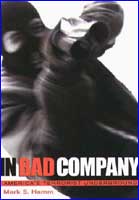 Hamm's In Bad Company is for Langan's ARA what The Silent Brotherhood is for Mathews' The
Order. It is thoroughly researched, comprehensive, attuned to the
political context it explores, and highly detailed in its depiction of the
people and events it describes. It also takes for granted, unfortunately,
that militant white activism is inherently irrational criminality, an
emotive acting out of deranged personalities. It assumes the targets of
white nationalist criticism are delusional figments of hateful
imaginations, with no legitimate referents in the real world, in a way
unthinkable in regard to black activists. As if the entire history of
white nationalism in America -- a history as old as the country itself,
existing long before, but including, the "reconstruction" era which made
race interests something whites had to start consciously thinking about --
were but a tale told by an idiot signifying nothing. Despite the vast body
of white nationalist literature explicitly detailing the social-political
realities murdering whites as a race and the freedoms they founded, it is
decided in advance that the entire issue really boils down to what The
Frankfurt School jews says it does: white pathology
. Forget about anti-white "affirmative action" programs (no whites need apply) and "hate crime" legislation (new and improved "white privilege" version 2.0). Ignore H1B visa abuse, a genocidal immigration policy, and a Mexican border as wide open as Nicole Brown Simpson's neck. Dismiss as a priori anti-Semitism the possibility that jews may have sculpted these policies to serve their own racist agenda, all while incrementally outlawing white history, culture, and any form of white racial community. Laugh it off as irrelevant that jews are the prime mover pushing America to sacrifice its blood and fortune to war against Israel's enemies. All of these issues, one must surmise, are too banal in their verifiability, too lackluster in their clarity. Far better to skirt them and instead conjecture about the secret motives and bizarre desires moving the men and women who take them seriously.
Hamm's In Bad Company is for Langan's ARA what The Silent Brotherhood is for Mathews' The
Order. It is thoroughly researched, comprehensive, attuned to the
political context it explores, and highly detailed in its depiction of the
people and events it describes. It also takes for granted, unfortunately,
that militant white activism is inherently irrational criminality, an
emotive acting out of deranged personalities. It assumes the targets of
white nationalist criticism are delusional figments of hateful
imaginations, with no legitimate referents in the real world, in a way
unthinkable in regard to black activists. As if the entire history of
white nationalism in America -- a history as old as the country itself,
existing long before, but including, the "reconstruction" era which made
race interests something whites had to start consciously thinking about --
were but a tale told by an idiot signifying nothing. Despite the vast body
of white nationalist literature explicitly detailing the social-political
realities murdering whites as a race and the freedoms they founded, it is
decided in advance that the entire issue really boils down to what The
Frankfurt School jews says it does: white pathology
. Forget about anti-white "affirmative action" programs (no whites need apply) and "hate crime" legislation (new and improved "white privilege" version 2.0). Ignore H1B visa abuse, a genocidal immigration policy, and a Mexican border as wide open as Nicole Brown Simpson's neck. Dismiss as a priori anti-Semitism the possibility that jews may have sculpted these policies to serve their own racist agenda, all while incrementally outlawing white history, culture, and any form of white racial community. Laugh it off as irrelevant that jews are the prime mover pushing America to sacrifice its blood and fortune to war against Israel's enemies. All of these issues, one must surmise, are too banal in their verifiability, too lackluster in their clarity. Far better to skirt them and instead conjecture about the secret motives and bizarre desires moving the men and women who take them seriously.
Books about "far right" activism are always the same. They translate a true tale of the inevitable death throes of a dispossessed majority into a conventionally fictitious morality play about a bunch of pathetic whites unable to deal appropriately with life's hard knocks, e.g., insecurity, failure, rejection, sexual confusion, drug dependency, etc, etc. Like that jew Lovitz character on SNL, they just want to be loved. And in lieu of love, they fill their "love vacuum" with -- you know this song, folks. Sing it with me! -- hate.
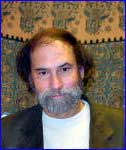 Hamm is a professor of criminology at Indiana State University, which may explain why he repeatedly underscores the demented character of the white nationalist worldview with phrases like, "...the federal government, which according to the ARA is controlled by Zionists..." [emphasis mine]. But never once does he use the same trick in reverse, i.e., address an issue from the actual perspective of the men he is chronicling, thereby subjecting readers' mainstream "commonsensical" assumptions to doubt. Here is what I mean:
Hamm is a professor of criminology at Indiana State University, which may explain why he repeatedly underscores the demented character of the white nationalist worldview with phrases like, "...the federal government, which according to the ARA is controlled by Zionists..." [emphasis mine]. But never once does he use the same trick in reverse, i.e., address an issue from the actual perspective of the men he is chronicling, thereby subjecting readers' mainstream "commonsensical" assumptions to doubt. Here is what I mean:
We see statements like this repeatedly:
"These paranoid haters saw affirmative action as an anti-white tool of the so-called 'Zionist Occupied government'...."
We never once see a statement like this:
"These so-called 'paranoid haters' were reacting to policies that actually are anti-white, a fact that for whatever reason continues to go unacknowledged in mainstream media discourse, the Jewish control of which is simultaneously widely known and self-destructive to utter."
This, of course, is due to a deeper problem with the book, one that compromises the integrity and intellectual value of nearly all works in this genre. Like Whitehead (Attack on Terror: The FBI Against the Klu klux Klan in Mississippi), Simonelli (American Fuehrer), and to a lesser extent Flynn and Gerhardt (Silent Brotherhood) and Schmaltz (Hate: George Lincoln Rockwell and the American Nazi Party), Hamm refuses to entertain even as a hypothetical
possibility that white resistance to dispossession may be justified. Not
once is it assumed, if only for the sake of argument, that white activism
may be as necessary in contemporary America as he obviously believes
jewish-led black resistance to "white oppression" was necessary in the
1960s. It's the "good for the goose, hate for the gander " phenomenon. It
is ubiquitous in post-'50s social-political literature and, sadly -- for
our standards once were, and should still be, much higher -- it is the
academic equivalent of VH1 devoting a special hour-long program to demonizing
white "hate rock" without once explaining how it differs from
rap.
Failing to address such a basic and obvious challenge to the very heart of
one's position would be academically unacceptable, if there were anything
on the other side of that challenge besides the verboten, dismissed-in-advance question of collective
white interests. What this shows is, in effect, even in
the upper echelons of academia, simple observance of reality is outlawed.
There is a single anti-white script and no one who deviates from it
will be employed, will get a book contract, will receive anything
but scorn and ruin from the establishment. Truth, as always where
jews hold power, is no defense.
As if by professional mandate, Hamm's criticisms of the criminal justice system are limited to the legitimate, but woefully inadequate, domain of class. For instance, Hamm juxtaposes Langan's arrest in 1974 with the arrest in the same year of heiress Patty Hearst:
Patty Hearst spent her time locked up in the aptly named federal prison at Pleasanton, California. Peter was processed into the...similarly well-named community of Starke. The American criminal justice system is no friend to the poor and alienated...(72).
That may be correct as far as it goes, but it stops far short of the truth. For Peter Langan the only significance of his lower class status was that, in newly integrated America, it subjected him to the brutal reality of race difference and conflict. Peter Langan was locked up with and repeatedly gang-raped by black criminals at age 16 because of forced integration, not his economic status. American prisons did not become black-on-white sexual predation factories until they were desegregated in 1965 -- just seven years before Langan would suffer the consequences -- as part of the jewish "civil rights" movement. Far from leveling the judicial playing field for all classes, desegregating prisons actually exacerbated class differences in prison treatment. Before 1965, white and black prisoners were housed among themselves, where their genetic and cultural behaviors would be relatively similar and interracial conflicts would be as far removed as intersexual conflicts. The threat of being a "big black buck's bitch" was not part of prison life for white men, no matter how poor they were, because they were housed with other whites. After 1965, however, generally less aggressive, more individualistic white males had to be rich to have a fighting chance to avoid jail, in other words, to avoid being "indiscrimately" submerged in a world of highly aggressive, gang-oriented blacks and other minorities.
The
grossly disproportionate non-white crime rate coupled with the jewish media's campaign to foster a sense of victimhood and anti-white hatred among minorities established the conditions making an integrated prison a veritable torture chamber for white prisoners. It de facto ensured that any white too poor to evade prison would be subjected to violent and sexual assaults by gangs of blacks and, more recently, Mexicans. Despite the liberal dogma that only whites prey on other races, the truth is as raw as a torn and bloody anus:
The racial dynamic in prisons puts whites at a tremendous disadvantage. First, whites are often outnumbered by both blacks and Hispanics. But far more important, just as they show no racial solidarity in "the free world," whites in prison do not band together to protect each other from predators. As No Escape reports, Hispanics sometimes rape Hispanics, and blacks sometimes rape blacks, but neither group permits anyone of another race to rape its own people. If a black tried to "turn out" a Mexican, the Mexicans would riot and try to kill him. Blacks also defend each other from white or Hispanic rapists. It is only whites-unless they are known members of white racialist gangs who do stick together-who are on their own and can be raped with impunity. It would be hard to think of a more cruel consequence of stripping whites of racial consciousness (Jared Taylor, "Hard Time," review of Joanne Mariner's
No Escape: Male Rape in U.S. Prisons).
American academia not only accepts but demands as a prerequisite for publication that authors discussing "the far right" suppress reality and adopt this entire fraudulent, ideologically anti-white framework. It not only skews the theoretical analysis of the subject matter, it shows in practice just how legitimate are the issues -- and perhaps the methods -- of militant white nationalist groups like The Order and ARA.
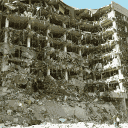 Skirting these hard
questions about race conflict in modern America, Hamm instead focuses
on two sensationalistic aspects of the ARA: Peter Langan's very confused sexuality and his own pet theory that links the ARA to Timothy McVeigh and the infamous bombing of the Alfred P. Murrah federal office building in Oklahoma City. Skirting these hard
questions about race conflict in modern America, Hamm instead focuses
on two sensationalistic aspects of the ARA: Peter Langan's very confused sexuality and his own pet theory that links the ARA to Timothy McVeigh and the infamous bombing of the Alfred P. Murrah federal office building in Oklahoma City.
Langan, it turns out, longed to be a woman. He repressed it for many years. He was married and had a child. Eventually, though, he confessed his desire to be a woman to his wife. Understandably, she was shocked and repulsed. They were soon separated. Langan began to actively pursue his peculiar sexual drives, until eventually he was living a full-blown double life. In between anti-ZOG raids on federal reserve banks and plotting major acts of domestic terrorism, Langan cross-dressed as a woman, complete with wig, dress, high heels, make up, and pink polished toenails. He assumed the transgender identity of "Donna McClure" and became a regular in the transgender niche of the gay scene. Those interested in this bizarre matter may look to the book for further details.
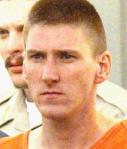 Hamm also attempts to link the ARA to Tim McVeigh and to establish the
existence of a wide, secret, criminal conspiracy behind the Oklahoma City
bombing. Here, too, I'll leave the details of Hamm's arguments to his
book and I'll leave it to those better versed in the subject to
judge. What I will comment on in this regard -- and this is relevant apart
from whether Hamm is correct or not -- is the propaganda factor
of Hamm's "necessary conspiracy" view.
Hamm also attempts to link the ARA to Tim McVeigh and to establish the
existence of a wide, secret, criminal conspiracy behind the Oklahoma City
bombing. Here, too, I'll leave the details of Hamm's arguments to his
book and I'll leave it to those better versed in the subject to
judge. What I will comment on in this regard -- and this is relevant apart
from whether Hamm is correct or not -- is the propaganda factor
of Hamm's "necessary conspiracy" view.
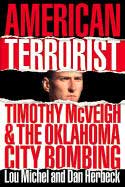 I read Michel and Herbeck's American Terrorist in 2001, when it was first released. The "lonewolf" narrative put forth in that book, which of course encompassed degrees of help from Terry Nichols and others, seemed plausible. Admittedly, the subject matter was alien to me. I had no idea about bomb ingredients or how common it was for folks in the Midwest to purchase thousands of pounds of ammonium nitrate fertilizer or hundreds of gallons of racecar fuel. But American Terrorist put all of this in context, addressing difficulties, explaining when certain acts were out of the ordinary, or how dumb luck thwarted (or caused) other unexpected issues. The outcome of the totality of events -- the detruction of the Murrah building and the death of 168 people -- was certainly extraordinary, but none of the individual steps along the way were far-fetched. More than anything else American Terrorist illustrated that with funding and knowledge in place -- i.e., knowing how to build the bomb and having the money to purchase the supplies -- the rest was a mere matter of personal commitment.
I read Michel and Herbeck's American Terrorist in 2001, when it was first released. The "lonewolf" narrative put forth in that book, which of course encompassed degrees of help from Terry Nichols and others, seemed plausible. Admittedly, the subject matter was alien to me. I had no idea about bomb ingredients or how common it was for folks in the Midwest to purchase thousands of pounds of ammonium nitrate fertilizer or hundreds of gallons of racecar fuel. But American Terrorist put all of this in context, addressing difficulties, explaining when certain acts were out of the ordinary, or how dumb luck thwarted (or caused) other unexpected issues. The outcome of the totality of events -- the detruction of the Murrah building and the death of 168 people -- was certainly extraordinary, but none of the individual steps along the way were far-fetched. More than anything else American Terrorist illustrated that with funding and knowledge in place -- i.e., knowing how to build the bomb and having the money to purchase the supplies -- the rest was a mere matter of personal commitment.
Hamm,
on
the
other hand,
contends that the bombing was so complex, so sophisticated, that it was highly improbable, if not impossible, for McVeigh to have accomplished it essentially alone. Hamm hypes up the difficulty of the job and makes even the initial drive-by inspections of the bombsite seem like Navy Seal-caliber expeditions. Hamm anachronistically interjects a danger and risk of detection presupposed only by those writing on domestic terrorism post-McVeigh. But consider it from an immdeiate American perspective. Today, in the midst of a national "war on terror," everyone reading this right now knows where a federal or state building is and where he could rent a truck. Armed guards do not surround these places. As Michel and Herbeck suggest, the only thing standing between an individual and a grand act of terrorism in today's America is a little money, a little knowledge, and a whole lot of personal commitment.
Again, I am not arguing that Hamm's theory is not
true -- it may very well account for the data better than the lone wolf
theory -- only that some of his basic assumptions about what is needed to
accomplish a profound act of terrorism are wrong. My point is this: even
if McVeigh were in fact part of a highly organized team of
terrorists that orchestrated the Murrah bombing, such a bombing does not
in principle
require such a team. One or two men could have committed the same act, as described in American Terrorist,
even if in fact they did not.
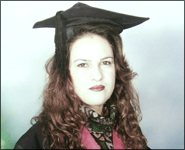 From a political standpoint, Hamm's claim that a team of dedicated fanatics is necessary to complete such a task serves to discourage would-be copycats by suggesting a level of complexity that may not in fact exist. It artificially bolsters the sense of an impregnable establishment and the futile impotence of the individual by claiming that layers and layers of specialization and skill are necessary where in fact sheer audacity could surely suffice. The Palestinian freedom fighters prove this. Despite
being under total martial law lockdown, they continue to take out a few
Israelis here and there on a regular basis. Despite constant surveillance,
check points, frequent raids, racial profiling, and absolutely no
inhibition on the part of either the IDF or civilian jews to shoot first
and tell the U.S. and UN to fuck off later, still the Palestinians find a way.
From a political standpoint, Hamm's claim that a team of dedicated fanatics is necessary to complete such a task serves to discourage would-be copycats by suggesting a level of complexity that may not in fact exist. It artificially bolsters the sense of an impregnable establishment and the futile impotence of the individual by claiming that layers and layers of specialization and skill are necessary where in fact sheer audacity could surely suffice. The Palestinian freedom fighters prove this. Despite
being under total martial law lockdown, they continue to take out a few
Israelis here and there on a regular basis. Despite constant surveillance,
check points, frequent raids, racial profiling, and absolutely no
inhibition on the part of either the IDF or civilian jews to shoot first
and tell the U.S. and UN to fuck off later, still the Palestinians find a way.
The mere existence of Hamm's book, In Bad Company, and so many others like it, raises an troubling question for anyone who believes America is a free nation with a free press:
Why is it easier for a white man to blow up a building (or rob a quarter million bucks from a dozen banks) than it is for a white man to publish a book honestly explaining why some white men might be compelled to do such things?
VICTOR WOLZEK
Edition reviewed:
Hamm, Mark S. In Bad Company: America's Terrorist Underground. Advanced uncorrected page proof. Boston: Northeastern University Press, 2002.
|
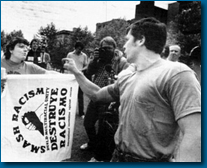 In 1984 white nationalist
In 1984 white nationalist 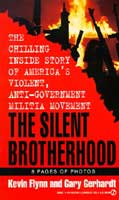 Langan was entrenched in white nationalism when he modeled the ARA after a mix of the Irish Republican Army (via The Irish Republican Army Handbook), The Order (via Flynn and Gerhardt's The Silent Brotherhood), and the Phineas Priesthood (via Hoskins' Vigilantes of Christendom). But, ironically, it was the U.S. Secret Service that gave him the opportunity to put his plan into action.
Langan was entrenched in white nationalism when he modeled the ARA after a mix of the Irish Republican Army (via The Irish Republican Army Handbook), The Order (via Flynn and Gerhardt's The Silent Brotherhood), and the Phineas Priesthood (via Hoskins' Vigilantes of Christendom). But, ironically, it was the U.S. Secret Service that gave him the opportunity to put his plan into action.
 By
1993 Langan was
set loose and set up in Ohio, where he was to cooperate with authorities in locating Guthrie. Langan, however, had other plans. He located his old friend Guthrie, and together they disappeared or "went to ether," as Langan phrased it. They rented a "safe house" in Pittsburg, Kansas. Together, along with a handful of others -- Scott Stedeford,
By
1993 Langan was
set loose and set up in Ohio, where he was to cooperate with authorities in locating Guthrie. Langan, however, had other plans. He located his old friend Guthrie, and together they disappeared or "went to ether," as Langan phrased it. They rented a "safe house" in Pittsburg, Kansas. Together, along with a handful of others -- Scott Stedeford,  Hamm's In Bad Company is for Langan's ARA what The Silent Brotherhood is for Mathews' The
Order. It is thoroughly researched, comprehensive, attuned to the
political context it explores, and highly detailed in its depiction of the
people and events it describes. It also takes for granted, unfortunately,
that militant white activism is inherently irrational criminality, an
emotive acting out of deranged personalities. It assumes the targets of
white nationalist criticism are delusional figments of hateful
imaginations, with no legitimate referents in the real world, in a way
unthinkable in regard to black activists. As if the entire history of
white nationalism in America -- a history as old as the country itself,
existing long before, but including, the "reconstruction" era which made
race interests something whites had to start consciously thinking about --
were but a tale told by an idiot signifying nothing. Despite the vast body
of white nationalist literature explicitly detailing the social-political
realities murdering whites as a race and the freedoms they founded, it is
decided in advance that the entire issue really boils down to what The
Frankfurt School jews says it does: white pathology
. Forget about anti-white "affirmative action" programs (no whites need apply) and "hate crime" legislation (new and improved "white privilege" version 2.0). Ignore H1B visa abuse, a genocidal immigration policy, and a Mexican border as wide open as Nicole Brown Simpson's neck. Dismiss as a priori anti-Semitism the possibility that jews may have sculpted these policies to serve their own racist agenda, all while incrementally outlawing white history, culture, and any form of white racial community. Laugh it off as irrelevant that
Hamm's In Bad Company is for Langan's ARA what The Silent Brotherhood is for Mathews' The
Order. It is thoroughly researched, comprehensive, attuned to the
political context it explores, and highly detailed in its depiction of the
people and events it describes. It also takes for granted, unfortunately,
that militant white activism is inherently irrational criminality, an
emotive acting out of deranged personalities. It assumes the targets of
white nationalist criticism are delusional figments of hateful
imaginations, with no legitimate referents in the real world, in a way
unthinkable in regard to black activists. As if the entire history of
white nationalism in America -- a history as old as the country itself,
existing long before, but including, the "reconstruction" era which made
race interests something whites had to start consciously thinking about --
were but a tale told by an idiot signifying nothing. Despite the vast body
of white nationalist literature explicitly detailing the social-political
realities murdering whites as a race and the freedoms they founded, it is
decided in advance that the entire issue really boils down to what The
Frankfurt School jews says it does: white pathology
. Forget about anti-white "affirmative action" programs (no whites need apply) and "hate crime" legislation (new and improved "white privilege" version 2.0). Ignore H1B visa abuse, a genocidal immigration policy, and a Mexican border as wide open as Nicole Brown Simpson's neck. Dismiss as a priori anti-Semitism the possibility that jews may have sculpted these policies to serve their own racist agenda, all while incrementally outlawing white history, culture, and any form of white racial community. Laugh it off as irrelevant that  Hamm is a professor of criminology at Indiana State University, which may explain why he repeatedly underscores the demented character of the white nationalist worldview with phrases like, "...the federal government, which according to the ARA is controlled by Zionists..." [emphasis mine]. But never once does he use the same trick in reverse, i.e., address an issue from the actual perspective of the men he is chronicling, thereby subjecting readers' mainstream "commonsensical" assumptions to doubt. Here is what I mean:
Hamm is a professor of criminology at Indiana State University, which may explain why he repeatedly underscores the demented character of the white nationalist worldview with phrases like, "...the federal government, which according to the ARA is controlled by Zionists..." [emphasis mine]. But never once does he use the same trick in reverse, i.e., address an issue from the actual perspective of the men he is chronicling, thereby subjecting readers' mainstream "commonsensical" assumptions to doubt. Here is what I mean: Skirting these hard
questions about race conflict in modern America, Hamm instead focuses
on two sensationalistic aspects of the ARA: Peter Langan's very confused sexuality and his own pet theory that links the ARA to Timothy McVeigh and the infamous bombing of the Alfred P. Murrah federal office building in Oklahoma City.
Skirting these hard
questions about race conflict in modern America, Hamm instead focuses
on two sensationalistic aspects of the ARA: Peter Langan's very confused sexuality and his own pet theory that links the ARA to Timothy McVeigh and the infamous bombing of the Alfred P. Murrah federal office building in Oklahoma City.
 Hamm also attempts to link the ARA to Tim McVeigh and to establish the
existence of a wide, secret, criminal conspiracy behind the Oklahoma City
bombing. Here, too, I'll leave the details of Hamm's arguments to his
book and I'll leave it to those better versed in the subject to
judge. What I will comment on in this regard -- and this is relevant apart
from whether Hamm is correct or not -- is the propaganda factor
of Hamm's "necessary conspiracy" view.
Hamm also attempts to link the ARA to Tim McVeigh and to establish the
existence of a wide, secret, criminal conspiracy behind the Oklahoma City
bombing. Here, too, I'll leave the details of Hamm's arguments to his
book and I'll leave it to those better versed in the subject to
judge. What I will comment on in this regard -- and this is relevant apart
from whether Hamm is correct or not -- is the propaganda factor
of Hamm's "necessary conspiracy" view.
 I read Michel and Herbeck's American Terrorist in 2001, when it was first released. The "lonewolf" narrative put forth in that book, which of course encompassed degrees of help from Terry Nichols and others, seemed plausible. Admittedly, the subject matter was alien to me. I had no idea about bomb ingredients or how common it was for folks in the Midwest to purchase thousands of pounds of ammonium nitrate fertilizer or hundreds of gallons of racecar fuel. But American Terrorist put all of this in context, addressing difficulties, explaining when certain acts were out of the ordinary, or how dumb luck thwarted (or caused) other unexpected issues. The outcome of the totality of events -- the detruction of the Murrah building and the death of 168 people -- was certainly extraordinary, but none of the individual steps along the way were far-fetched. More than anything else American Terrorist illustrated that with funding and knowledge in place -- i.e., knowing how to build the bomb and having the money to purchase the supplies -- the rest was a mere matter of personal commitment.
I read Michel and Herbeck's American Terrorist in 2001, when it was first released. The "lonewolf" narrative put forth in that book, which of course encompassed degrees of help from Terry Nichols and others, seemed plausible. Admittedly, the subject matter was alien to me. I had no idea about bomb ingredients or how common it was for folks in the Midwest to purchase thousands of pounds of ammonium nitrate fertilizer or hundreds of gallons of racecar fuel. But American Terrorist put all of this in context, addressing difficulties, explaining when certain acts were out of the ordinary, or how dumb luck thwarted (or caused) other unexpected issues. The outcome of the totality of events -- the detruction of the Murrah building and the death of 168 people -- was certainly extraordinary, but none of the individual steps along the way were far-fetched. More than anything else American Terrorist illustrated that with funding and knowledge in place -- i.e., knowing how to build the bomb and having the money to purchase the supplies -- the rest was a mere matter of personal commitment.
 From a political standpoint, Hamm's claim that a team of dedicated fanatics is necessary to complete such a task serves to discourage would-be copycats by suggesting a level of complexity that may not in fact exist. It artificially bolsters the sense of an impregnable establishment and the futile impotence of the individual by claiming that layers and layers of specialization and skill are necessary where in fact sheer audacity could surely suffice. The
From a political standpoint, Hamm's claim that a team of dedicated fanatics is necessary to complete such a task serves to discourage would-be copycats by suggesting a level of complexity that may not in fact exist. It artificially bolsters the sense of an impregnable establishment and the futile impotence of the individual by claiming that layers and layers of specialization and skill are necessary where in fact sheer audacity could surely suffice. The